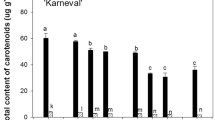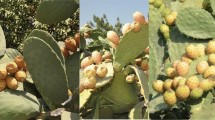Abstract
The influence of two growing locations (soil types), six fruit sizes, and two years on the postharvestBeta-carotene content of muskmelon (Cucumis melo L. var. reticulatus Naud.) fruit was studied with two different cultivars. Fully abscised commercial size fruit: 9, 12, 15, 18, 23, and 30 (fruit/0.04 M3 shipping box) had highly variableBeta-carotene contents (5.3 to 33.8 µg/g fresh weight) that varied by size class, soil type and cultivar.Beta-carotene content increased with fruit size up to a maximum, though fruit size continued to increase. Find sandy loam soil produced fruit with lessBeta-carotene content than silty clay loam soil. The cultivar Primo contained higherBeta-carotene content levels than cultivar Cruiser. Mesocarp percent moisture content for both ‘Cruiser’ and ‘Primo’ at both locations by fruit size was not significantly correlated (r=0.40) withBeta-carotene content. Indicating fruit cell dilution may not contribute to the differences inBeta-carotene content in different fruit size classes.Beta-carotene content of size class ‘18’ fruit from six cultivars grown on the silty clay loam soil for two consecutive years, showed a year, and year by cultivar effect for some cultivars. Whereas, some cultivars did not differ inBeta-carotene content between the two years. This indicates a potential for controllingBeta-carotene content of muskmelon fruit at a constant, high level by careful selection of production cultivar.
Similar content being viewed by others
References
Devlin RM (1975) Plant physiology, 3rd. ed. New York: Van Nostrand.
Craft NE, Wise SA (1993) Individual carotenoid content of SRM 1548 total diet and influence of storage carotenoids. J Agric Food Chem 41: 208–213.
Butrum RR, Clifford CK, Lanza E (1988) NCI dietary guidelines: Rational. Am J Clin Nutr 48: 888–895.
Adams CF (1975) Nutritive value of American foods: In common units. Agriculture Handbook No. 456. Washington, DC: US Dept. of Agriculture.
Goodwin TW, Goad LJ (1970) Carotenoids and triterpenoids. In AC Hulme (ed), The biochemistry of fruits and their products, Vol 1, pp 305–368. New York: Academic Press.
Curl AL (1966) The carotenoids of muskmelon. J Food Sci 31: 759–761.
Lester GE, Dunlap JR (1985) Physiological changes during development and ripening of ‘Perlita’ muskmelon fruits. Sci Hort 26: 323–331.
Reid MS, Lee TH, Pratt HK, Chichester CO (1970) Chlorophyll and carotenoid changes in developing muskmelons. J Am Soc Hort Sci 95: 814–815.
Vavich MG, Kemmerer AR (1950) The carotenes of cantaloupes. Food Res 15: 494–497.
Thompson, CM, Sanders RR, Williams D (1972) Soil survey of Starr County, Texas, US pp 16–17. Dept. of Agr.-Soil Conserve. Ser. and Texas Agr. Expt. Sta. Weslaco, TX.
Lester GE, Oebker NF, Coons J (1994) Preharvest furrow and drip irrigation schedule effects on postharvest muskmelon quality. Postharvest Bio Tech 4: 57–63.
Khachik F, Beecher GR, Goli MB, Lusby WR (1991) Separation, identification, and quantification of carotenoids in fruits, vegetables and human plasma by high performance liquid chromatography. Pure & Appl Chem 63: 71–80.
SAS (1988) SAS user's guide: Statistics. Cary, NC: SAS Institute.
Lee CY (1986) Changes in carotenoid content of carrots during growth and postharvest storage. Food Chem 20: 285–293.
Author information
Authors and Affiliations
Additional information
Mention of a trademark of propriety does not constitute a guarantee or warranty of the product by the US Department of Agriculture or Texas A&M University and does not imply its approval to the exclusion of other products that also may be suitable.
Rights and permissions
About this article
Cite this article
Lester, G.E., Eischen, F. Beta-carotene content of postharvest orange-fleshed muskmelon fruit: Effect of cultivar, growing location and fruit size. Plant Food Hum Nutr 49, 191–197 (1996). https://doi.org/10.1007/BF01093215
Received:
Accepted:
Issue Date:
DOI: https://doi.org/10.1007/BF01093215




